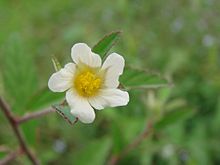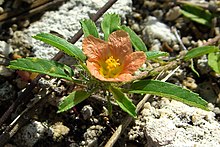Genus of flowering plants
Sida genus of flowering plants in the mallow family, Malvaceae . They are distributed in tropical and subtropical regions worldwide,[2] [3] fanpetals [1] sidas .[4]
Description
These are annual or perennial herbs or shrubs growing up to 2m tall (6 feet). Most species have hairy herbage. The leaf blades are usually unlobed with serrated edges, but may be divided into lobes. They are borne on petioles and have stipules . Flowers are solitary or arranged in inflorescences of various forms. Each has five hairy sepals and five petals in shades of yellow, orange, or white. There are many stamens and a style divided into several branches. The fruit is a disc-shaped schizocarp up to 2 cm (3/4 inch) wide which is divided into five to 12 sections, each containing one seed. The pollens are spherical in shape.
Three pollen grains of a plant in genus Sida [3] [4]
Ecology
Many Sida are attractive to butterflies and moths . Arrowleaf sida (Sida rhombifolia larval host for the tropical checkered skipper (Pyrgus oileus [5]
The Sida golden mosaic virus and Sida golden yellow vein virus have been first isolated from Sida species; the former specifically from Sida santaremensis .
Etymology
The genus name Sida is from the Greek for "pomegranate or water lily".[4] Carl Linnaeus adopted the name from the writings of Theophrastus .[3]
Diversity
Sida has historically been a wastebasket taxon , including many plants that simply did not fit into other genera of the Malvaceae. Species have been continually reclassified.[2] circumscription of Sida is still unclear, with no real agreement regarding how many species belong there. Over 1000 names have been placed in the genus, and many authorities accept about 150 to 250 valid names today.[2] [6] Sida that have not yet been described to science.[7]
Sida rhombifolia Sida ciliaris Sida linifolia Species include:[1] [6] [8]
Sida abutifolia Mill. – prostrate sida, spreading fanpetalsSida acuta Burm.f. S. carpinifolia ) – common wireweed, broomweedSida aggregata C.Presl – savannah fanpetalsSida antillensis – Antilles fanpetalsSida calyxhymenia – rock sida, tall sidaSida cardiophylla (Benth. ) F.Muell.Sida ciliaris – bracted fanpetals, fringed fanpetalsSida clementii Domin Sida cordata – long-stalk sida, heartleaf fanpetalsSida cordifolia L. – country-mallow, flannel sidaSida echinocarpa F.Muell. Sida elliottii – Elliott's fanpetalsSida fallax Walp. ʻ ilima, yellow ʻ ilimaSida glabra – smooth fanpetalsSida glomerata – clustered fanpetalsSida hermaphrodita Sida intricata F.Muell. – twiggy sidaSida jamaicensis – Jamaican fanpetalsSida javensis Sida lindheimeri – showy fanpetalsSida linifolia – flaxleaf fanpetals, balai grandSida longipes – stockflower fanpetalsSida mysorensis Wight & Arnott Sida neomexicana – New Mexico fanpetalsSida nesogena Sida phaeotricha F.Muell. – hill sidaSida picklesiana [7] Sida pusilla Sida repens – Javanese fanpetalsSida rhombifolia L. – arrowleaf sida, Cuban juteSida rubromarginata – red-margin fanpetalsSida salviifolia – escoba parada Sida santaremensis – moth fanpetalsSida spenceriana F.Muell. Sida spinosa – prickly sida, prickly fanpetalsSida tragiifolia – catnip noseburn, earleaf fanpetalsSida trichopoda F.Muell. – hairy sidaSida troyana Sida ulmifolia Mill. – common wireweed, common fanpetals[9] Sida urens – tropical fanpetals, balai-zortie
Formerly placed here
Species now in other genera include:[8]
Abutilon abutiloides (Jacq.) Garcke ex Hochr. (as S. abutiloides Jacq. or S. lignosa Cav. )Abutilon cristata (L.) Schltdl. (as S. cristata L. )Abutilon giganteum (Jacq.) Sweet (as S. gigantea Jacq. )Abutilon grandifolium (Willd.) Sweet (as S. grandifolia Willd. or S. mollis Ortega )Abutilon hirtum (Lam.) Sweet (as S. graveolens Roxb. ex Hornem. )Abutilon incanum (Link) Sweet (as S. incana Link )Abutilon indicum (L.) Sweet (as S. indica L. )Abutilon megapotamicum (A.Spreng.) A.St.-Hil. & Naudin (as S. megapotamica A.Spreng. )Abutilon mollissimum (Cav.) Sweet Sida mollicoma Willd. (as S. mollissima Cav. )Abutilon pictum (Gillies ex Hook. & Arn.) Walp. (as S. picta Gillies ex Hook. & Arn. )Abutilon reflexum (Juss. ex Cav.) Sweet (as S. reflexa Juss. ex Cav. )Abutilon sellowianum (Klotzsch) Regel (as S. sellowiana Klotzsch )Abutilon theophrasti Medik. (as S. abutilon L. )
Bakeridesia integerrima (Hook.) D.M.Bates (as S. integerrima Hook. )Corynabutilon vitifolium (Cav.) Kearney (as S. vitifolium Cav. )Malvastrum hispidum (Pursh) Hochr. (as S. hispida Pursh )Malvella leprosa (Ortega) Krapov. (as S. hederacea (Douglas) Torr. ex A.Gray )Nototriche compacta (Gay) A.W.Hill (as S. compacta Gay )Pavonia sepium A. St.-Hil. (as S. malvacea Vell. )Sidalcea malviflora (DC.) A.Gray ex Benth. (as S. malviflora DC. )Sidalcea oregana subsp. oregana S. oregana Nutt. ex Torr. & A.Gray )Sidastrum micranthum (A.St.-Hil.) Fryxell (as S. micrantha A.St.-Hil. )Sidastrum paniculatum (L.) Fryxell (as S. paniculata L. )Sphaeralcea grossulariifolia (Hook. & Arn.) Rydb. (as S. grossulariifolia Hook. & Arn. )Wissadula periplocifolia (L.) C.Presl ex Thwaites (as S. periplocifolia L. )




